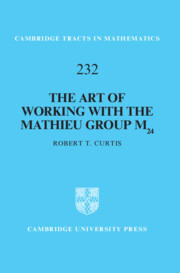Book contents
- Frontmatter
- Dedication
- Contents
- Figures
- Tables
- Preface
- Acknowledgements
- 1 Introduction
- 2 Steiner Systems
- 3 The Miracle Octad Generator
- 4 The Binary Golay Code
- 5 Uniqueness of the Steiner System S(5, 8, 24) and the Group M24
- 6 The Hexacode
- 7 Elements of the Mathieu Group M24
- 8 The Maximal Subgroups of M24
- 9 The Mathieu Group M24
- 10 The Leech Lattice M24
- 11 The Conway Group ·O
- 12 Permutation Actions of M24
- 13 Natural Generators of the Mathieu Groups
- 14 Symmetric Generation Using M24
- 15 The Thompson Chain of Subgroups of Co1
- Appendix MAGMA Code for 7★36 : A9 ↦ Co1
- References
- Index
14 - Symmetric Generation Using M24
Published online by Cambridge University Press: 31 October 2024
- Frontmatter
- Dedication
- Contents
- Figures
- Tables
- Preface
- Acknowledgements
- 1 Introduction
- 2 Steiner Systems
- 3 The Miracle Octad Generator
- 4 The Binary Golay Code
- 5 Uniqueness of the Steiner System S(5, 8, 24) and the Group M24
- 6 The Hexacode
- 7 Elements of the Mathieu Group M24
- 8 The Maximal Subgroups of M24
- 9 The Mathieu Group M24
- 10 The Leech Lattice M24
- 11 The Conway Group ·O
- 12 Permutation Actions of M24
- 13 Natural Generators of the Mathieu Groups
- 14 Symmetric Generation Using M24
- 15 The Thompson Chain of Subgroups of Co1
- Appendix MAGMA Code for 7★36 : A9 ↦ Co1
- References
- Index
Summary
We describe the method of symmetric generation of groups that has been used to produce pleasing, well-motivated constructions of many of the sporadic simple groups. A progenitor 2*n : N is defined to be a free product of n copies of the cyclic group of order 2, extended by a permutation group N of degree n that permutes these n involutory symmetric generators by conjugation. A useful lemma is introduced that leads to suitable relations by which to factor the infinite progenitor in order to produce a finite image that contains n distinct involutions permuted by an isomorphic copy of N. These ideas are employed using N ≅ M24.
In the first case, we have n =(244) and the symmetric generators correspond 4 to tetrads of points of Ω. Factoring this by a single short relation results in the Conway group ·O and the symmetric generators spontaneously reveal themselves to be the negatives of the Conway elements ξT.
In the second case, we have n = 3795 and the symmetric generators correspond to the trios. The Lemma leads us to two simple relations and factoring by them results in the largest Janko group J4. In fact one of the relations is essentially redundant and John Bray has shown that omitting it leads to a group J4 × 2. In order to prove these assertions in the two cases, we first use known representations to verify that the group claimed is indeed an image of the progenitor and satisfies the additional relations. We then use the double coset enumerator of John Bray and the author, written in Magma, to show that the image has the right order. Unfortunately in both these cases the group N ≅ M24 is too small to enumerate double cosets of form NwN and so we use theoretical arguments to identify subgroups H ≅ 212 : M24
and H ≅ 211 : M24
, respectively, and enumerate double cosets of form HwN.
- Type
- Chapter
- Information
- The Art of Working with the Mathieu Group M24 , pp. 209 - 233Publisher: Cambridge University PressPrint publication year: 2024

